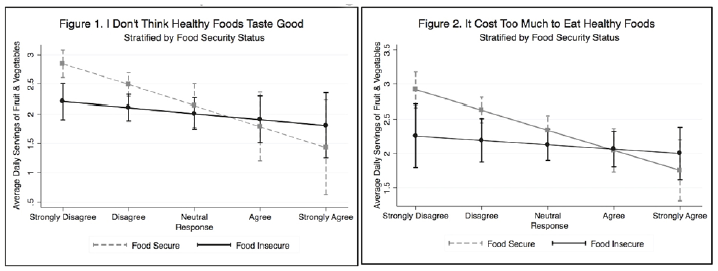The moderating effect of food security status on the association between documented barriers and fruit and vegetable intake
Barriers to fruit and vegetable intake
Diets rich in nutrient-dense foods like fruit and vegetables can promote health, prevent obesity, and lower risk for chronic diseases, such as heart disease, type 2 diabetes, and cancer. Despite these benefits, most Americans do not meet recommendations for daily fruit and vegetable intake. Studies investigating barriers to fruit and vegetable intake have identified several key factors associated with consumption, including: taste preferences, food preparation time, cost, and access. While most studies control for socio-economic variables, few consider the role of food insecurity. Food insecurity is commonly associated with poor nutrition and diet, poor health, and higher rates of female obesity, after controlling for income. The objective of this study was to investigate whether the relationship between barriers to healthy food consumption and reported intake rates differs by food security status.
This study utilized cross-sectional data collected within economically deprived neighborhoods to investigate the association between self-reported barriers to healthy food consumption and dietary intake of residents in Oakland, California from 2013 to 2014. Recruitment materials were sent to residents (n=10,792) in selected economically deprived census tracts. The analytic sample included 531 participants. The Johns Hopkins Institutional Review Board approved the study, including an unsigned, passive consent form.
Using a 26-item Dietary Screener Questionnaire (DSQ), we measured average daily intake of fruit and vegetables. We also assessed self-reported barriers to healthy food consumption, including:
- Micro-level barriers: taste preference, cost restrictions, and time to prepare food (“busyness”),
- Mezzo-level barriers: assessments of produce selection, quality, and availability.
Multivariate linear regression assessed associations between micro- and mezzo-level barriers and reported fruit and vegetable intake. We assessed variation in the association between barriers to healthy food consumption and fruit and vegetable intake by food security status with an interaction term. Food security status was collected using the USDA ERS 6-item food security scale.
Study results
We found important differences by food security status in the relationship between perceived barriers to consumption and selfreported fruit and vegetable consumption, after controlling for income.
Among the food secure, disliking healthy food taste (ßcost taste: -0.38; 95% CI: -0.60, -0.15) and cost concerns (ßcost: -0.29; 95% CI: -0.44, -0.15) were associated with lower intakes of fruit and vegetables. Subsequently, interventions making healthy foods more appealing, easy to prepare, and more cost efficient may be effective among the food secure.

Interestingly, fruit and vegetable intake among the food insecure was associated with busyness but not taste or cost. The lack of association with taste preferences is consistent with literature suggesting lower-resource households feel they have less choice when it comes to diet, given their constrained resources. A food secure family may be able to discriminate between foods based on taste preferences, while a food insecure family may have fewer options when shopping on a limited budget. The lack of association between cost concerns and intake in this study is unexpected; other studies have found cost highly influential on food decisions among low-resource populations, and food insecure respondents in this study were three times as likely as food secure respondents to report cost concerns as a barrier. However, some studies have found low-resource households do not always report cost as a direct barrier to healthy food intake. Households may be accustomed to budgeting for low consumption rates of fruit and vegetables such that they no longer consider cost a barrier. More research is needed on the association between taste, cost and consumption among food insecure populations.
Being “too busy” to prepare healthy foods
Contrary to the moderating effect played by food security in taste and cost analyses, feeling too busy to prepare healthy foods (“busyness”) was associated with reduced intake among both food secure and food insecure populations. This finding is consistent with other studies that have found busyness and preparation time to be associated with intake, particularly among low resource families. Given that higher rates of in-home food preparation are associated with higher diet quality, attempting to reduce healthy food preparation time (actual or perceived), increase the convenience of accessing healthy food, or provide more meal-planning resources may be appropriate for both food secure and food insecure populations.
Next steps
These results suggest that food security status should be included in studies investigating barriers to healthy food intake, in addition to income, and food security status should be considered when designing and targeting dietary intervention and policy suggestions.
Based on: Mook, K., Laraia, B. A., Oddo, V. M., & Jones-Smith, J. C. (2016). Peer Reviewed: Food Security Status and Barriers to Fruit and Vegetable Consumption in Two
Economically Deprived Communities of Oakland, California, 2013–2014. Preventing chronic disease, 13.
